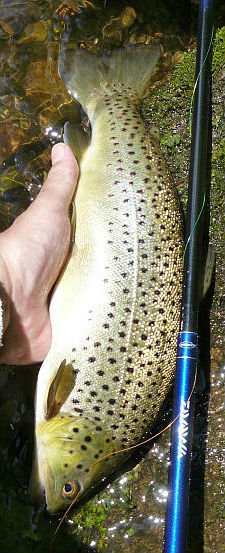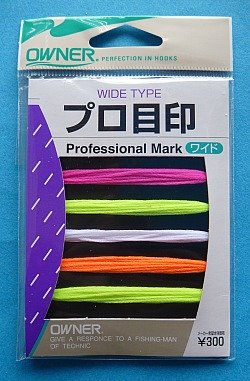Trip Report - 7-6-14
A Keiryu Lesson
Prologue
To say that my trip last Sunday was an eye opener would be an understatement. I have done a lot of fishing with keiryu rods, going back to the first Daiwa Kiyose 30SF rods I began importing in 2012. However, by far most of that fishing has been tenkara fishing. I call it tenkara fishing because it was with a tenkara line and with a fly, casting the weight of the line rather than the weight of the fly. Even the times I fished a beadhead nymph, which was pretty rare, I used a tenkara line - a heavy one to smooth out the cast.
Until very recently I had experimented only a few times with a keiryu rig - a very light line, too thin to see, with yarn markers or plastic flag markers for strike detection and a split shot to provide the weight for casting. The first time was on a small stream with substantial streamside brush and an overhead canopy of tree branches. I caught nothing but trees. The second time was on a stream I had never fished before, and though I caught no trees I also caught no fish. It was windy enough that the flag markers caused substantial drag.
On my trip to Maine in early June, I fished with a keiryu rig quite a bit. By then I had already determined that a size 12 Killer Bugger (and better yet, a size 6) was heavy enough to cast with a long, light action keiryu rod without any additional weight. I had also determined that I like the yarn markers much better than the flag markers. They're lighter weight and thus cause significantly less sag on the line. Since one of the primary benefits of using a keiryu rig over a tenkara rig is less line sag, the lighter yarn markers are definitely better.
As the photo below shows, the three yarn markers (upper right corner) are quite visible against the water. They are also quite visible at the furthest extent of your cast.
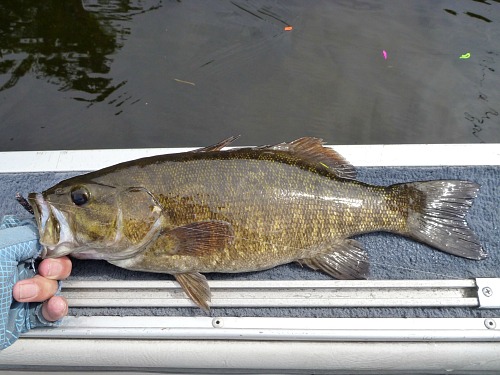 Fluorescent Keiryu Markers are extremely visible.
Fluorescent Keiryu Markers are extremely visible.My fishing in Maine was all lake fishing, so my approach was to cast as far as I could with a line (rod tip to fly) equal to the rod length. Since I was often using a 6.3m rod, that was still an appreciable distance. As soon as the fly hit the water I would begin lifting the rod tip to keep the markers off the surface. The fly was thus pulled towards me as the rod tip was elevated. With the line always tight from pulling the fly, almost all strikes were felt. There were only a couple situations where I didn't feel the strike. In one case the indicators dove down and towards me and in the other they started moving sideways.
A couple weekends ago I tried a keiryu rig again on a relatively small stream. This time it worked much better, although the focus for the day was racking up species for the TenkaraBum Challenge. One interesting catch that didn't make it into the 6-22-14 trip report was a nice trout I caught on an artificial wax worm. We have rubber worms for bass fishing, but it turns out the Japanese have rubber wax worms for keiryu fishing. They work, too!
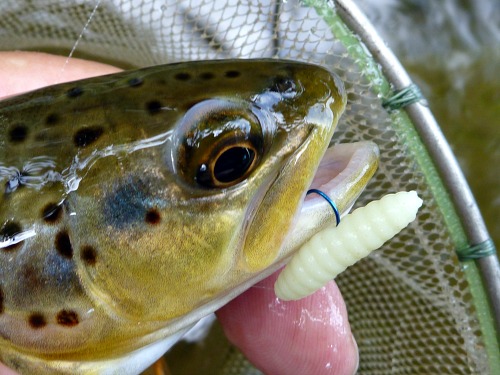 First cast with the artificial wax worm in a trout stream!
First cast with the artificial wax worm in a trout stream!Trip Report 7-6-14
Sorry for the long intro. What was eye opening last Sunday was seriously fishing a keiryu rig in a stream - albeit with a beadhead Killer Bugger rather than a split shot and bait. I may never fish a weighted fly with a tenkara line again!
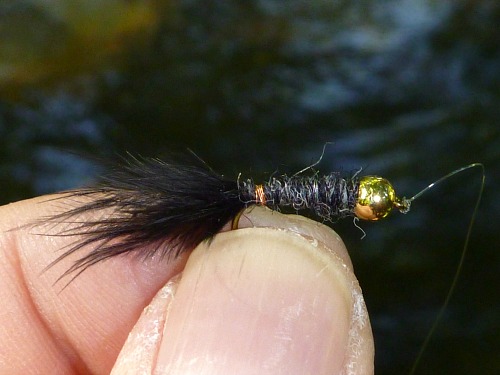 I tried gold and black beads. The gold worked much better.
I tried gold and black beads. The gold worked much better.I don't know how many times I have written that I'll fish with the longest rod and lightest line I can get away with. The combination of the long rod and light line allow you to keep your line off the water's surface and this minimizes drag. Well guess what? Keiryu rods are longer and keiryu lines are lighter. Put the two together and drag is minimized even further!
Sunday I was not fishing with the longest rod I could get away with. I'd wanted to get some pics with the recently introduced Nissin Sensui 330 and also with the Nissin Fine Mode Kosasansui 270. Although the rods were relatively short, the line I used was a size 1 (equivalent to 4X tippet material), much lighter than any tenkara line. I may end up stocking the line. It's an Ayu fishing line rather than a Keiryu line (why would that stop me), but it's hi-vis. It's too thin to see well in the shade, but in full sun it's certainly more visible than clear fluorocarbon tippet material. It comes in the sizes that keiryu rods are rated for and is no more expensive than the Varivas fluorocarbon tippet.
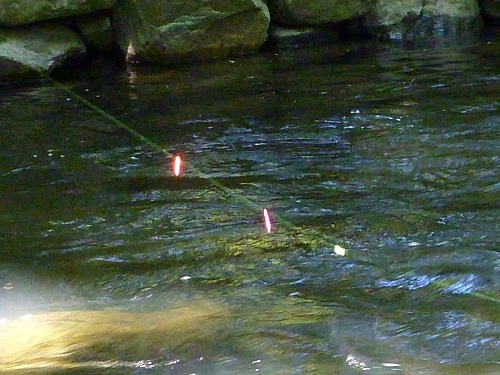 An autofocus point & shoot will always focus on the background
rather than the line and markers.
An autofocus point & shoot will always focus on the background
rather than the line and markers.In addition to the light line, I used Keiryu Markers
for strike detection. As I had noticed when using a keiryu rig in
Maine, almost all strikes were felt. Most were immediately obvious.
There were only a couple that appeared to be rocks, but when I tightened
up to see if it was a rock or a fish, I got a head shake.
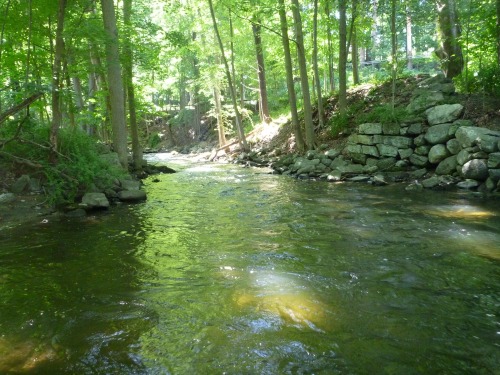 Much higher water than normal.
Much higher water than normal.The first stream is relatively small but was running much higher than normal following recent rains. I thought it would be a good place to do some keiryu "Czech Nymphing." I was really very surprised at the ability to keep a tight line and keep the bead head Killer Bugger drifting at the right speed (just a bit slower than the surface water). Even though the rod was shorter than I could have used for this stream, I was able to keep a very tight line which was not subject to cross currents and which easily registered strikes.
The Nissin Sensui is a pretty stiff rod and it transmitted the "tap" of a fish very effectively.
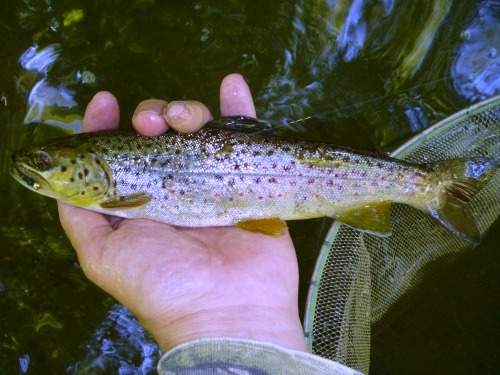 The fish weren't big, but they were cooperative.
The fish weren't big, but they were cooperative.I've often read that in Czech nymphing, one "leads" the nymph or nymphs downstream, which keeps the line tight. It does that, but it also causes them to go faster than the current they're in. The current near the bottom is slower than the surface current as rocks, etc., disrupt the flow. To achieve a natural drift, you would have to not lead the nymph downstream but resist the pressure of the surface current on the line, effectively restraining the nymphs rather than leading them.
That's actually impossible to do if you are fishing upstream, but with the line much closer to vertical (because of the longer rod and the lighter line) there is less line in the water for the surface current to press against. Most of the fish I caught were when the line was nearly opposite from where I was standing, and the line very nearly vertical.
 View from the bridge
View from the bridgeThe second stream I went to was much wider, and thus I could not keep a vertical line with a 3.3m rod. This, however, is where the eye opening really started to take place. I'd fished the same stream just a week before, using a Daiwa Enshou LL41SF. On that day, I fished a size 12 Black Killer Bugger with a 4m Tenkara Midi line. I'd caught some nice fish that day.
On this trip, with the shorter 3.3m Nissin Sensui, a line the diameter of 4X tippet material and a gold bead head Black Killer Bugger, the fishing was much more productive. I think there are three reasons for that: 1) the bead head got the fly deeper, and on a bright sunny day I think that matters - a lot, 2) the line was so much thinner that it had almost no sag to it. It was much easier to keep a tight line and to keep line off the water - even though the rod was shorter! 3) I think the gold bead head attracted strikes. I also fished on Sunday with a black bead head (which looked quite a lot like the flies I'd fished the previous week) and the gold was significantly more productive.
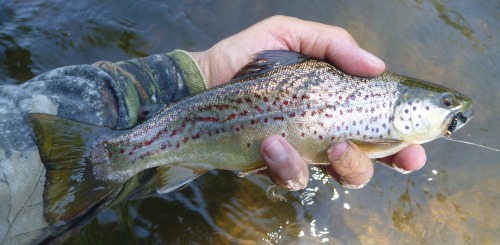 It wasn't a "many" day, but it was a good day.
It wasn't a "many" day, but it was a good day.As with many things, there was no one element that alone led to success. I believe it was the combination of the extremely light line and the weighted fly that not only allowed a deeper presentation but also a more natural drag-free presentation.
I can't wait to try the same rig on a longer rod. Actually, my longer rods are rated for even thinner lines. I specifically went with the "heavier" size 1 line for the Sensui because it has one of the heaviest ratings for a keiryu rod. The Daiwa Kiyose 43M and 53M can use a line as light as a size .4 (equivalent to 7X). You are NOT going to get line sag when fishing with 7X for your casting line! For that matter, with the more reasonable 5X you won't get enough to worry about.
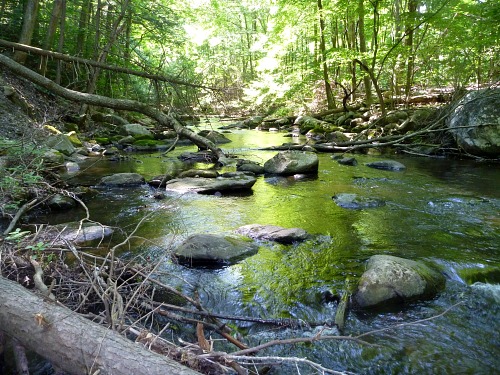 Technical fishing with short, precise casts needed.
Technical fishing with short, precise casts needed.The third stream of the day was smaller and much more technical. I decided to come here to try for a few pics for the new Small Stream Tenkara Starter Kit. I started fishing with a size 3.5 tenkara line and quickly picked up a couple fish.
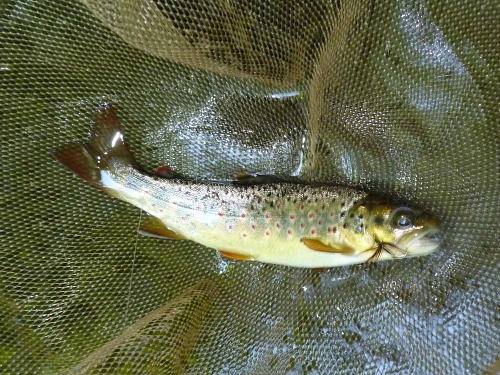 A black bodied, brown hackled Ishigaki fooled this little brownie.
A black bodied, brown hackled Ishigaki fooled this little brownie.It wasn't too long, though, before I got the idea to try a keiryu rig on this stream as well. I mean, if the Japanese rod companies make keiryu rods as short as 2.4m, they must be for use on tiny streams, right? My 2.7m Kosansui ought to be just right for a small, technical stream.
I've read comments from a couple American tenkara anglers who've tried keiryu fishing on small streams. Both said they preferred tenkara, with one citing the difficulty he experienced casting with a canopy of tree branches. His lob casts kept getting snagged.
It didn't take long to realize that casts don't have to be overhead lobs. With a bead head fly, a tip action rod and a quick casting stroke, I was able to achieve remarkably straight shot casts. Surprisingly, I got snagged more while casting the tenkara line than I did after I switched to the keiryu line. The biggest difference, of course, was that the keiryu line was shorter, but with a bead head fly it was also in a much lower plane (more sidearm).
What was even more surprising was that the flourescent yellow yarn markers I was using were infinitely more visible than the fluorescent orange tenkara line I had started with. Still, as in the first two streams and also in the lake in Maine, by far, most strikes were felt rather than seen.
I remember a comment John Vetterli had made, following conversations with Japanese keiryu anglers, to the effect that the yarn markers weren't really to indicate strikes as much as to just tell you where your line is. One thing they very clearly indicated was whether the line was straight and tight or had slack. You feel strikes on a tight line, you don't on a slack line.
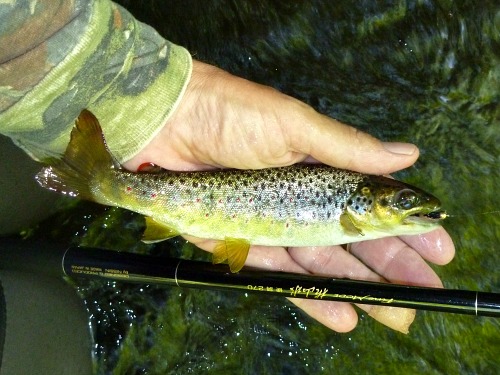
Lesson Learned
I have often written that for fishing heavy flies, a keiryu rod is better than a tenkara rod. Following this day's fishing, I will modify that to say for fishing heavy flies, a keiryu RIG (rod, line and markers) is better than a tenkara rod and tenkara line. The extremely light line (as light as you dare) will give you even better presentations than you'll get with a tenkara line. It will be easier to keep the line tight and many more strikes will be felt.
I later learned, from my own experience and from customers, that frequently you will feel a strike but by the time you react the fish is already gone. I now believe that you want either some slack in the line so that the line will register a strike before the slack disappears and the fish feels the tension of the tight line, or you want a keiryu rod with a very flexible tip so it will allow the fish to pull line, causing your markers to dip, but not feel the tension of a tight line pulling on a stiff rod tip.
I have also written often that if you are waiting to feel the strike you are waiting too long. As tight as a tenkara line is compared to a PVC fly line snaking across the surface, a keiryu line is just that much tighter. You will indeed feel the strikes.
I will say that if you are fishing unweighted flies in the top few inches of the water column (or on the surface), the tenkara rod and line is the way to go. That is what tenkara rods and lines were designed for and they are very good at it. If you want to fish in the bottom few inches of the water column, though, I feel now more than ever that keiru rods and lines are the way to go. After all, that's what THEY were designed for.
TenkaraBum Home > Trip Reports > Trip Report 7-6-14
“The bitterness of poor quality remains long after the sweetness of low price is forgotten” - Benjamin Franklin
"Be sure in casting, that your fly fall first into the water, for if the line fall first, it scares or frightens the fish..." -
Col. Robert Venables 1662
As age slows my pace, I will become more like the heron.
We've all had situations where seriously chewed up flies kept catching fish after fish after fish. It is no sin to tie flies that come off the vise looking seriously chewed up.
Warning:
The hooks are sharp.
The coffee's hot.
The fish are slippery when wet.
Beware of the Dogma
What's in stock?
Suntech Tenkarakyo 40F Tenkara Rods
Coming Soon
December
Kurenai II AR 30F
Kurenai II AR 33F
Kurenai II AR 39F
Nissin Oni Line size 3
Nissin Oni Line size 3.5
TenkaraBum 33
TenkaraBum 36
TenkaraBum 40
Medium Rod Case
January
Furaibo TF39
Furaibo TF39TA
Latest Pages
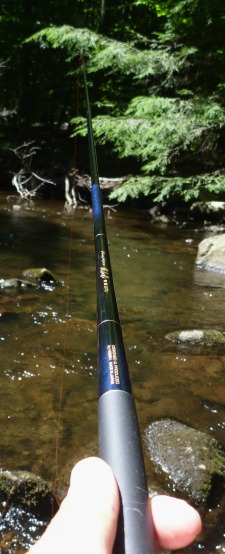 Fine Mode Kosansui 270
Fine Mode Kosansui 270I just wanted to tell how thrilled I am with the Owner markers. My winter fishing catch rate went from one to two on a good day to six to twelve!
I am using my Tenkarabum 36 and a twelve foot Keiryu line on very brushy streams. Who says you need a long rod, short line?
Keiryu fishing blows away the level line in the nymphing category.
Walter A, Washington
If you enjoy spin fishing or baitcasting please visit my sister site Finesse-Fishing.com.



